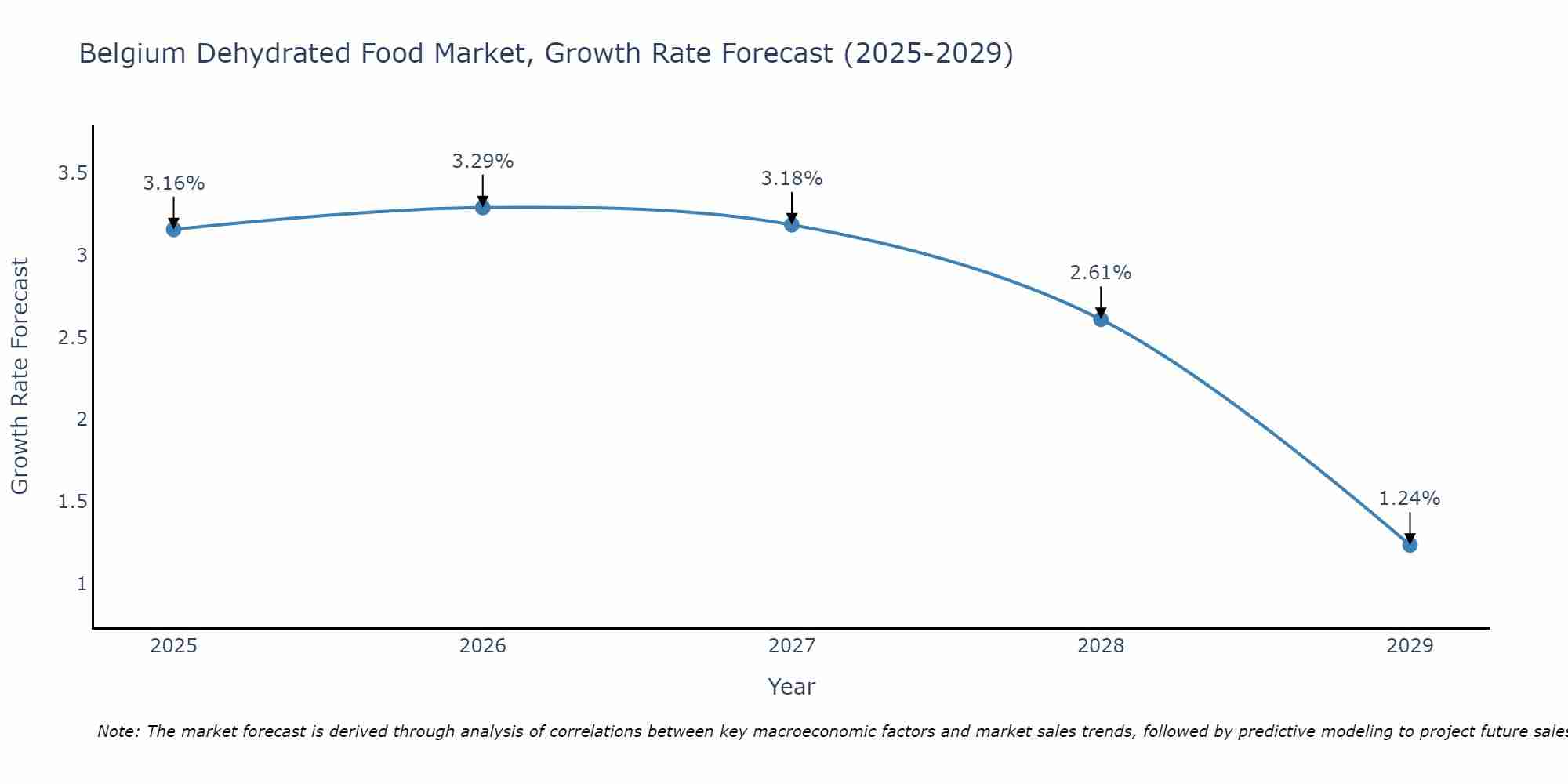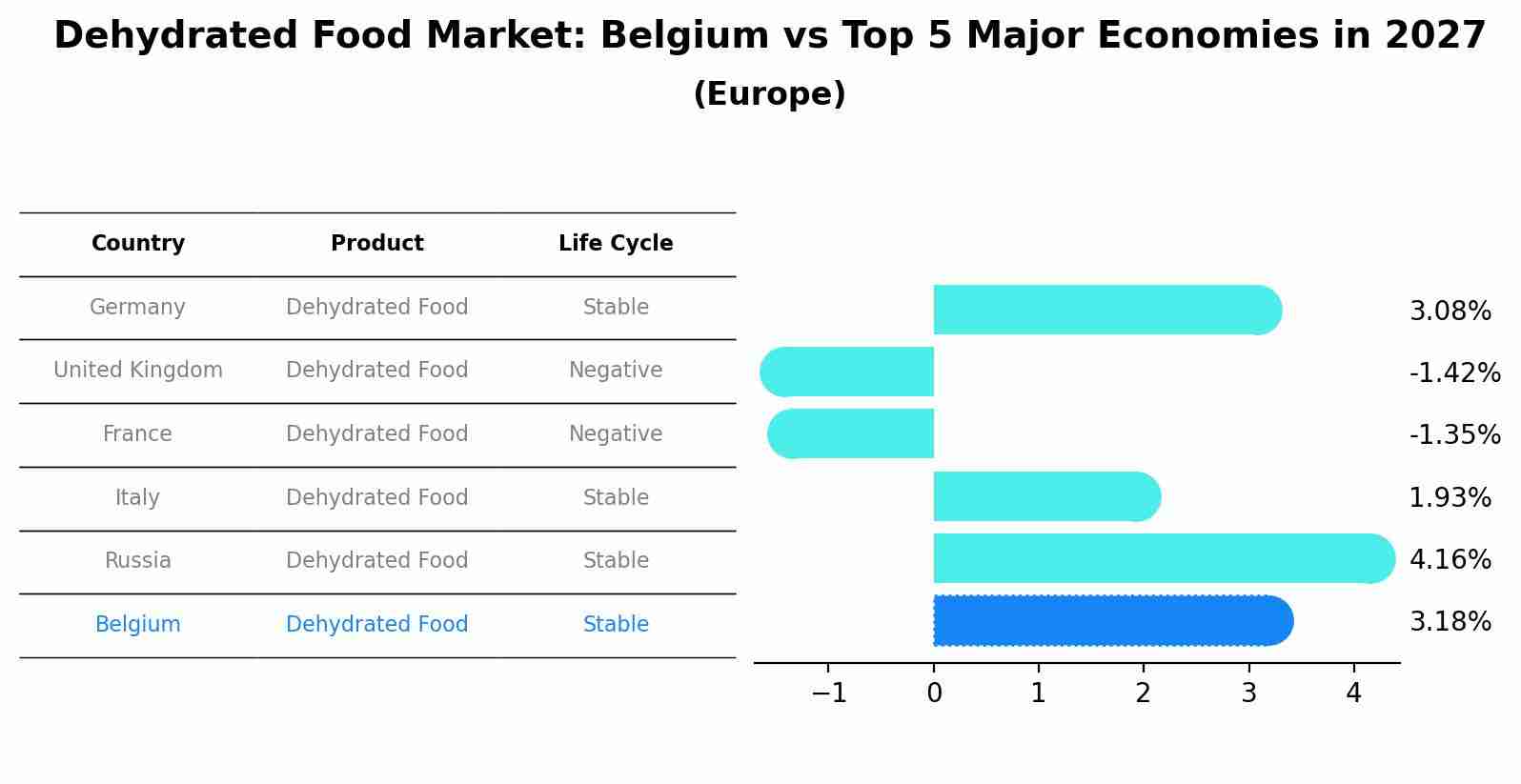Belgium Dehydrated Food Market (2025-2031) | Trends, Revenue, Forecast, Companies, Growth, Analysis, Size, Outlook, Share, Segmentation, Value & Industry
| Product Code: ETC4837213 | Publication Date: Nov 2023 | Updated Date: Apr 2025 | Product Type: Market Research Report | |
| Publisher: 6Wresearch | Author: Sachin Kumar Rai | No. of Pages: 60 | No. of Figures: 30 | No. of Tables: 5 |
Belgium Dehydrated Food Market Size Growth Rate
The Belgium Dehydrated Food Market is projected to witness mixed growth rate patterns during 2025 to 2029. The growth rate begins at 3.16% in 2025, climbs to a high of 3.29% in 2026, and moderates to 1.24% by 2029.

Dehydrated Food Market: Belgium vs Top 5 Major Economies in 2027 (Europe)
By 2027, the Dehydrated Food market in Belgium is anticipated to reach a growth rate of 3.18%, as part of an increasingly competitive Europe region, where Germany remains at the forefront, supported by United Kingdom, France, Italy and Russia, driving innovations and market adoption across sectors.

Belgium Dehydrated Food Market Overview
The Belgium dehydrated food market is witnessing growth due to the rising demand for long-shelf-life food products. Dehydrated foods, including fruits, vegetables, and meats, are popular among consumers for their convenience and nutritional value. The market is bolstered by innovations in drying technologies and increasing consumer awareness about healthy eating.
Drivers of the market
The growth of the Belgium dehydrated food market is primarily fueled by the increasing consumer preference for convenient and long-shelf-life food products. The busy lifestyles of modern consumers and the rising trend of outdoor recreational activities have boosted the demand for dehydrated food. Moreover, advancements in dehydration technology and the expansion of the food processing industry support market growth. The growing awareness of food wastage reduction also plays a significant role in driving the market.
Challenges of the market
The Belgium dehydrated food market is challenged by consumer preferences shifting towards fresh and minimally processed foods. Despite the convenience and extended shelf life of dehydrated products, perceptions of inferior taste and nutritional value compared to fresh counterparts hinder market growth. Additionally, fluctuations in raw material prices and the high energy costs associated with dehydration processes impact profit margins. Strict food safety regulations and the need for significant investment in technology and equipment also present obstacles for manufacturers.
Government Policy of the market
The Belgian government supports the dehydrated food market through policies aimed at ensuring food security and promoting sustainable agricultural practices. Subsidies and incentives for food processing companies, along with stringent food safety regulations, help maintain high standards and encourage innovation in dehydration technologies.
Key Highlights of the Report:
- Belgium Dehydrated Food Market Outlook
- Market Size of Belgium Dehydrated Food Market, 2024
- Forecast of Belgium Dehydrated Food Market, 2031
- Historical Data and Forecast of Belgium Dehydrated Food Revenues & Volume for the Period 2021-2031
- Belgium Dehydrated Food Market Trend Evolution
- Belgium Dehydrated Food Market Drivers and Challenges
- Belgium Dehydrated Food Price Trends
- Belgium Dehydrated Food Porter`s Five Forces
- Belgium Dehydrated Food Industry Life Cycle
- Historical Data and Forecast of Belgium Dehydrated Food Market Revenues & Volume By Type for the Period 2021-2031
- Historical Data and Forecast of Belgium Dehydrated Food Market Revenues & Volume By Spray-dried for the Period 2021-2031
- Historical Data and Forecast of Belgium Dehydrated Food Market Revenues & Volume By Freeze-dried for the Period 2021-2031
- Historical Data and Forecast of Belgium Dehydrated Food Market Revenues & Volume By Vacuum-dried for the Period 2021-2031
- Historical Data and Forecast of Belgium Dehydrated Food Market Revenues & Volume By Drum-dried for the Period 2021-2031
- Historical Data and Forecast of Belgium Dehydrated Food Market Revenues & Volume By Others for the Period 2021-2031
- Historical Data and Forecast of Belgium Dehydrated Food Market Revenues & Volume By Product for the Period 2021-2031
- Historical Data and Forecast of Belgium Dehydrated Food Market Revenues & Volume By Dried Processed Food for the Period 2021-2031
- Historical Data and Forecast of Belgium Dehydrated Food Market Revenues & Volume By Dried Fruit & Vegetable for the Period 2021-2031
- Historical Data and Forecast of Belgium Dehydrated Food Market Revenues & Volume By Dried Dairy for the Period 2021-2031
- Historical Data and Forecast of Belgium Dehydrated Food Market Revenues & Volume By Dried Meat & Seafood for the Period 2021-2031
- Historical Data and Forecast of Belgium Dehydrated Food Market Revenues & Volume By Others for the Period 2021-2031
- Historical Data and Forecast of Belgium Dehydrated Food Market Revenues & Volume By Distribution Channel for the Period 2021-2031
- Historical Data and Forecast of Belgium Dehydrated Food Market Revenues & Volume By Hypermarket/Supermarket for the Period 2021-2031
- Historical Data and Forecast of Belgium Dehydrated Food Market Revenues & Volume By Convenience Stores for the Period 2021-2031
- Historical Data and Forecast of Belgium Dehydrated Food Market Revenues & Volume By Online Retailing for the Period 2021-2031
- Historical Data and Forecast of Belgium Dehydrated Food Market Revenues & Volume By Others for the Period 2021-2031
- Belgium Dehydrated Food Import Export Trade Statistics
- Market Opportunity Assessment By Type
- Market Opportunity Assessment By Product
- Market Opportunity Assessment By Distribution Channel
- Belgium Dehydrated Food Top Companies Market Share
- Belgium Dehydrated Food Competitive Benchmarking By Technical and Operational Parameters
- Belgium Dehydrated Food Company Profiles
- Belgium Dehydrated Food Key Strategic Recommendations
Frequently Asked Questions About the Market Study (FAQs):
1 Executive Summary |
2 Introduction |
2.1 Key Highlights of the Report |
2.2 Report Description |
2.3 Market Scope & Segmentation |
2.4 Research Methodology |
2.5 Assumptions |
3 Belgium Dehydrated Food Market Overview |
3.1 Belgium Country Macro Economic Indicators |
3.2 Belgium Dehydrated Food Market Revenues & Volume, 2021 & 2031F |
3.3 Belgium Dehydrated Food Market - Industry Life Cycle |
3.4 Belgium Dehydrated Food Market - Porter's Five Forces |
3.5 Belgium Dehydrated Food Market Revenues & Volume Share, By Type, 2021 & 2031F |
3.6 Belgium Dehydrated Food Market Revenues & Volume Share, By Product, 2021 & 2031F |
3.7 Belgium Dehydrated Food Market Revenues & Volume Share, By Distribution Channel, 2021 & 2031F |
4 Belgium Dehydrated Food Market Dynamics |
4.1 Impact Analysis |
4.2 Market Drivers |
4.3 Market Restraints |
5 Belgium Dehydrated Food Market Trends |
6 Belgium Dehydrated Food Market Segmentations |
6.1 Belgium Dehydrated Food Market, By Type |
6.1.1 Overview and Analysis |
6.1.2 Belgium Dehydrated Food Market Revenues & Volume, By Spray-dried, 2021-2031F |
6.1.3 Belgium Dehydrated Food Market Revenues & Volume, By Freeze-dried, 2021-2031F |
6.1.4 Belgium Dehydrated Food Market Revenues & Volume, By Vacuum-dried, 2021-2031F |
6.1.5 Belgium Dehydrated Food Market Revenues & Volume, By Drum-dried, 2021-2031F |
6.1.6 Belgium Dehydrated Food Market Revenues & Volume, By Others, 2021-2031F |
6.2 Belgium Dehydrated Food Market, By Product |
6.2.1 Overview and Analysis |
6.2.2 Belgium Dehydrated Food Market Revenues & Volume, By Dried Processed Food, 2021-2031F | 6.2.3 Belgium Dehydrated Food Market Revenues & Volume, By Dried Fruit & Vegetable, 2021-2031F |
6.2.4 Belgium Dehydrated Food Market Revenues & Volume, By Dried Dairy, 2021-2031F |
6.2.5 Belgium Dehydrated Food Market Revenues & Volume, By Dried Meat & Seafood, 2021-2031F |
6.2.6 Belgium Dehydrated Food Market Revenues & Volume, By Others, 2021-2031F |
6.3 Belgium Dehydrated Food Market, By Distribution Channel |
6.3.1 Overview and Analysis |
6.3.2 Belgium Dehydrated Food Market Revenues & Volume, By Hypermarket/Supermarket, 2021-2031F |
6.3.3 Belgium Dehydrated Food Market Revenues & Volume, By Convenience Stores, 2021-2031F |
6.3.4 Belgium Dehydrated Food Market Revenues & Volume, By Online Retailing, 2021-2031F |
6.3.5 Belgium Dehydrated Food Market Revenues & Volume, By Others, 2021-2031F |
7 Belgium Dehydrated Food Market Import-Export Trade Statistics |
7.1 Belgium Dehydrated Food Market Export to Major Countries |
7.2 Belgium Dehydrated Food Market Imports from Major Countries |
8 Belgium Dehydrated Food Market Key Performance Indicators |
9 Belgium Dehydrated Food Market - Opportunity Assessment |
9.1 Belgium Dehydrated Food Market Opportunity Assessment, By Type, 2021 & 2031F |
9.2 Belgium Dehydrated Food Market Opportunity Assessment, By Product, 2021 & 2031F |
9.3 Belgium Dehydrated Food Market Opportunity Assessment, By Distribution Channel, 2021 & 2031F |
10 Belgium Dehydrated Food Market - Competitive Landscape |
10.1 Belgium Dehydrated Food Market Revenue Share, By Companies, 2024 |
10.2 Belgium Dehydrated Food Market Competitive Benchmarking, By Operating and Technical Parameters |
11 Company Profiles |
12 Recommendations | 13 Disclaimer |
- Single User License$ 1,995
- Department License$ 2,400
- Site License$ 3,120
- Global License$ 3,795
Search
Related Reports
- Portugal Electronic Document Management Market (2025-2031) | Strategy, Consumer Insights, Analysis, Investment Trends, Opportunities, Growth, Size, Share, Industry, Revenue, Segments, Value, Segmentation, Supply, Forecast, Restraints, Outlook, Competition, Drivers, Trends, Demand, Pricing Analysis, Competitive, Strategic Insights, Companies, Challenges
- France Electronic Document Management Market (2025-2031) | Strategy, Consumer Insights, Analysis, Investment Trends, Opportunities, Growth, Size, Share, Industry, Revenue, Segments, Value, Segmentation, Supply, Forecast, Restraints, Outlook, Competition, Drivers, Trends, Demand, Pricing Analysis, Competitive, Strategic Insights, Companies, Challenges
- Portugal Occupational Health & Safety Services Market (2025-2031) | Strategy, Consumer Insights, Analysis, Investment Trends, Opportunities, Growth, Size, Share, Industry, Revenue, Segments, Value, Segmentation, Supply, Forecast, Restraints, Outlook, Competition, Drivers, Trends, Demand, Pricing Analysis, Competitive, Strategic Insights, Companies, Challenges
- Netherlands Occupational Health and Safety Services Market (2025-2031) | Strategy, Consumer Insights, Analysis, Investment Trends, Opportunities, Growth, Size, Share, Industry, Revenue, Segments, Value, Segmentation, Supply, Forecast, Restraints, Outlook, Competition, Drivers, Trends, Demand, Pricing Analysis, Competitive, Strategic Insights, Companies, Challenges
- Belgium and Luxembourg Facility Management Market (2025-2031) | Strategy, Consumer Insights, Analysis, Investment Trends, Opportunities, Growth, Size, Share, Industry, Revenue, Segments, Value, Segmentation, Supply, Forecast, Restraints, Outlook, Competition, Drivers, Trends, Demand, Pricing Analysis, Competitive, Strategic Insights, Companies, Challenges
- Russia Women Intimate Apparel Market (2025-2031) | Strategy, Consumer Insights, Analysis, Investment Trends, Opportunities, Growth, Size, Share, Industry, Revenue, Segments, Value, Segmentation, Supply, Forecast, Restraints, Outlook, Competition, Drivers, Trends, Demand, Pricing Analysis, Competitive, Strategic Insights, Companies, Challenges
- Africa Chocolate Market (2025-2031) | Size, Share, Trends, Growth, Revenue, Analysis, Forecast, industry & Outlook
- Global Hydroxychloroquine And Chloroquine Market (2025-2031) | Industry, Trends, Size, Outlook, Growth, Value, Companies, Revenue, Analysis, Share, Forecast
- Saudi Arabia Plant Maintenance Market (2025-2031) | Industry, Size, Growth, Revenue, Value, Companies, Forecast, Analysis, Share & Trends
- Taiwan Electric Truck Market (2025-2031) | Outlook, Industry, Revenue, Size, Forecast, Growth, Analysis, Share, Companies, Value & Trends
Industry Events and Analyst Meet
Our Clients
Whitepaper
- Middle East & Africa Commercial Security Market Click here to view more.
- Middle East & Africa Fire Safety Systems & Equipment Market Click here to view more.
- GCC Drone Market Click here to view more.
- Middle East Lighting Fixture Market Click here to view more.
- GCC Physical & Perimeter Security Market Click here to view more.
6WResearch In News
- Doha a strategic location for EV manufacturing hub: IPA Qatar
- Demand for luxury TVs surging in the GCC, says Samsung
- Empowering Growth: The Thriving Journey of Bangladesh’s Cable Industry
- Demand for luxury TVs surging in the GCC, says Samsung
- Video call with a traditional healer? Once unthinkable, it’s now common in South Africa
- Intelligent Buildings To Smooth GCC’s Path To Net Zero













